
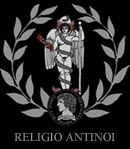
Pantheon of Antinous Gods
The sacred images of Antinous, lovingly housed in the museums of the world show that Hadrian intended us to know that Antinous was a myriad of sacred beings contained in one. With this as our model, let us be free to love Antinous in his full and various forms, without the notion that any one supercedes the others, for they are all the truth of his divinity, and they are all illusions. The true Antinous, the boy who was born in Bithynia, whom Hadrian loved, and who was assumed into the Nile is a complete stranger. This is the god whom we seek, who calls out to us, the most mysterious, and the most beautiful of all his forms. This is the boy who fell into the Nile and emerged as a God.
The comparisons which were made by Hadrian and his mythologists between Antinous and the more famous gods were meant to communicate his message to the masses who may not have understood the written or spoken oracles that were being woven to further his deification. If you understand Dionysus, then you will begin to understand Antinous, if you understand Osiris, then you will begin to understand Antinous, if you understand the constellation Aquila, then you will begin to understand the Star of Antinous. But the written words have been lost, and His name has been erased from the maps of heaven, only the statues remain to guide our way. With these perfect images as our compass, let us remember that the majority does not portray Antinous with the attributes of any god at all, but entirely naked, and as human as any of us. This gives the impression that Antinous was an unprecedented God, comparable to the famous gods only to an extent, which we must first understand, and then depart from.
These are only a few of the many ways that lead to the true Antinous, any one of which constitutes the whole of his religion. Through his grace, may they lead us to the Black Star that is the gateway to his salvation.
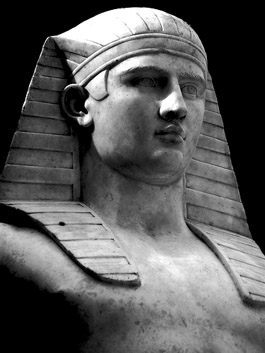
ANTINOUS OSIRIS
The first believers in Antinous were the Egyptian peasants and Kemetic Priests who had joined the Imperial fleet on its journey up the Nile. They recognized that the sacrifice of Antinous by drowning in the Nile had made him a god after their ancient tradition. Therefore the earliest form of his worship is the Egyptian, which regarded Antinous as one of the Nile deities, numbering him among their Daimons. Antinous can therefore be worshipped with the full attributes of the Egyptian religion. In Antinopolis two Temples were built, one Greek and the other Egyptian. The two faiths coexisted harmoniously, but the Egyptian believers remained fully part of the more ancient Kemetic Faith. The attributes of Osiris were applied to Antinous. In this sense, Antinous is like the lost Phallus of Osiris that was never recovered from the Nile, as though it had drowned, lending its fertility to the river mud that inundated the fields and promoted the fecundity of the harvest. The death of Antinous is therefore his willful sacrifice for the maintenance of the principle of Maat, ensuring the peace and stability of the world at the cost of his life. He died so that millions would live. The flooding of the Nile that immediately followed his drowning was the first miracle and sign of his deification.
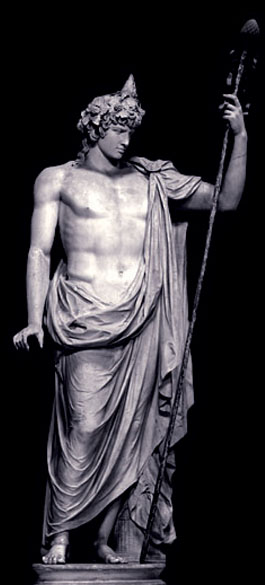
ANTINOUS BACCHUS
The second Temple of Antinous at Antinopolis was dedicated to Antinous the Divine Ephebe. It was the greater of the two Temples because the city of Antinopolis was a colony of Greco-Roman civilization in the heart of Egypt. Greek people were purposefully encouraged to immigrate to the city. It was adorned with all the comforts of Greek civilization that Hadrian so admired. Antinous was closely assimilated to Bacchus, the god of the vine, who was also considered to be eternally young and beautiful. His spirit of freedom and indulgent liberation made him popular among the repressed such as woman, slaves, artists and homosexuals. Bacchus-Dionysus, like Osiris was a fertility god, the ecstasy of drunkenness was said to be his gift to mankind. The majority of images of Antinous portray him in the costume of Bacchus, with the wreath of ivy, the pinecone topped staff called a Thyrsus, and the skin of a leopard. Antinous-Bacchus was worshipped by a guild of artists in Rome, most likely they were actors and poets. The sculptors who portrayed him with such loving perfection were undoubtedly part of his cult. All of these crafts were notorious for being the occupations of homosexuals then as they are now. This particular manifestation of Antinous is therefore the place in which Hadrian purposefully was speaking to Roman homosexuals, giving them a new god in which to believe, one who epitomized all that they treasured about the beauty of the male sex. This god, Antinous-Bacchus, embodies the orgiastic mystery cults of the Greco-Roman faith, and was the most widespread form of his religion. One can therefore express the Roman faith through veneration of Antinous as the God of drunkenness and freedom that was the gift of Bacchus to mankind.
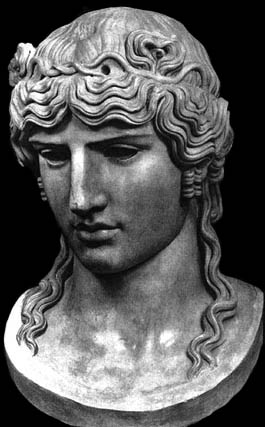
ANTINOUS APOLLO
Many of the Statues, such as the one above, show Antinous with the attributes of Apollo, the cultured and refined god of the arts. Hadrian was the most Apollonian of all the Emperors. He brought new life to the classical arts, sponsoring sculptors, and painters to imitate and even excel the ancient masters. The proliferation of statues of Antinous that in so many ways imitate and surpass the ancient Greek masterpieces are an example of the Apollonian aspect of the religion of Antinous. The handmaiden of Apollo were the Muses, who were inspired by the perfection of creation, and in turn inspired mankind to recreate this perfection through the arts. The longest lasting sect of the religion of Antinous is that which admires his images as the pinnacle of late classical art. So much more has been written about his images than about his faith, that for many this is the extent of his worship. One can therefore venerate and adore Antinous through the love of his image, through pure idolatry, first as an admirer and then as an artist. The Cytharode of Curium, sang a beautiful hymn to Antinous to the accompaniment of his lyre. The poet Pancrates wrote an epic poem about the Maurosian lion hunt. The sculptors, under the careful direction of Hadrian recreated the true image of Antinous by the thousands. Cardinal Alessandro Albani, in the early 1700's exhibited his faith in Antinous by becoming the foremost collector of his images in the world, even to this day. Oscar Wilde and Fernando Pessoa, and Marguerite Yourcenar, have all written poems and novels that have kept the memory and elegance of Antinous, the god who inspires the arts, alive. By admiring the graceful art of Antinous, and by recreating him, one can take part in the religion of Antinous-Apollo.
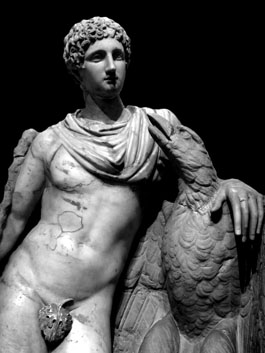
ANTINOUS GANYMEDE
The mystery of the star of Antinous is found in the veneration of Antinous Ganymede who is the spirit of the Age of Aquarius. He is the cup bearer of the gods who pours the wine of eternal life. He is the youth and gentleness, innocence and play. Carried up to heaven in the arms of the eagle, Antinous Ganymede is the soul of the believer, that shall likewise be uplifted when it has tasted the sweetness of his mouth. The Astrologers were only revealing what they saw. A boy who in radiant form closely resembled Ganymede, having been carried away from his home by the living God of Rome. Antinous was taken from obscurity and placed at the very forefront of the world by Hadrian, the New Zeus, as unpredictable, and as glorious in deeds. The eagle that from earliest time has been a celestial and national symbol of power. The image of Strength, Justice, glory, Power, and the freedom of the sky. Taking hold of a dove, it becomes a conjunction of forces. Power and Love, Majesty and Beauty, Justice and Peace, Desire and Perfection, Logic and Wisdom...Life and Death. The love of Hadrian for antinous is the love that all men have for youth, in others and in themselves. Adoration of Antinous Ganymede is the desire to partake of his cup of immortality, to perpetuate the brilliance of youthful joy as though death was no more than a fairytale.
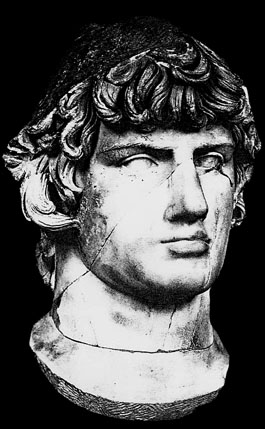
ANTINOUS ATTIS
Antinous was from the modern nation of Turkey, another name for this nation is Phrygia. It is a country with a very long history, as long as any other in human history. From the time of Catal Huyuk, the earliest settlement ever found, to the Hittite Empire, to the Trojan War, to the Seven Churches of the Book of Revelation, to the mystic poems of Jalaludin Rumi, Phrygia has had its own history and its own spiritual identity that is distinct from the Hellenic culture into which it is absorbed. The primary Roman god that exemplifies this difference is the God Attis, and the cult of the Great Mother of the Gods. Attis was a beautiful boy that was driven insane by the love of the Great Mother Cybele, he is said to have castrated himself beneath a pine tree, and that from his blood sprouted violet flowers. Rome took to this religion with great austerity. The center of this violent religion of self-inflicted mutilation was then located on the Vatican Hill, present site of the Basilica of St. Peter. A few images portray Antinous with the pine needle wreath that was the symbol of Attis. These priests of the Great Mother, after castrating themselves, lived the rest of their lives in the costume of a woman. They were drag-queen priests, responsible for spreading the fertility of the Great Mother to the fields of the Earth, by shedding their blood upon the ground. The practice lives on even now in the Roman Catholic cult of penitential brotherhoods in Spain, the Philippines, Mexico and the South Western United States. Although the practice of cross-dressing has been discontinued, the blood letting has not. Attis was said to have been born from the river Sangarius, that also flowed through Bithynia, the birthplace of Antinous. After castrating himself, Attis died beneath a pine tree, after bathing his bleeding groin in the river Gallus. The image of Attis dying by the Gallus river is said to be an allegory of the dying boy god, or the sun, dying by the side of the Milky Way, on the winter solstice. Under Antinous-Attis, the practice of sacred cross-dressing, and of androgyny is sanctified. One can therefore partake of the ancient Phrygian mysteries through the spirit of androgyny, and sacred cross-dressing.
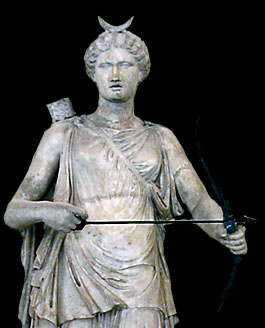
ANTINOUS DIANA
Hadrian and Antinous enjoyed hunting, it was perhaps their favorite pastime. Only a few images remain that show them together and in all of them they are shown involved in the hunt. The round relief sculptures of the arch of Constantine show Hadrian and Antinous hunting a boar, and also, standing with both their feet over the body of a slain lion, perhaps the Maurosian lion from the epic poem by Pancrates. It is believed that this hunt was viewed as a spiritual task of overcoming the chaos of nature by the skill of mankind. An inscription remains that is dedicated to Antinous and Diana, the goddess of the hunt, revealing that these two deities, both regarded as homosexuals, were closely related. Antinous is like the male version of Diana, and indeed almost all the dying boy gods are regarded as hunters, including the famous Adonis. Dogs are therefore sacred to Antinous as the hunter. The length of time that Antinous spent with Hadrian is roughly equivalent to the life span of a hunting dog. Antinous has all the characteristics of a fine hound, he was beautiful, refined, strong, masculine, young, virile, full of life, tender, precious, affectionate, moody, emotional, lazy, perhaps ferocious, easily depressed, yet full of joy, and intensely loyal to Hadrian, even to the point of suicide. This canine aspect to Antinous and the thrill of the hunt are another facet to his religion that in many ways contradict so much of the rest of his more established religion, but is perhaps the most definite aspect from his true life. Though little is known about the real Antinous, the only certainty is that he was a hunter.
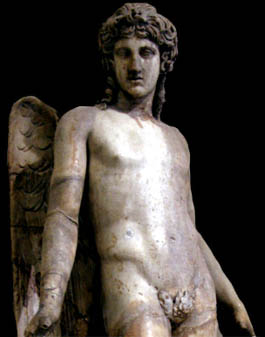
ANTINOUS EROS
The Emperor Hadrian devoted his religious efforts towards the development of three deities. The first was Zeus-Jupiter, the second was Venus, and the third was Antinous. The Greeks proclaimed Hadrian to be the living embodiment of Zeus, and the spiritual father of the country. Hadrian's personal faith however was centered on the goddess Venus. He built a magnificent Temple to Venus in Rome, one of the largest Temples in the city. To him Venus was the Mother of the Roman people, and the protectoress of the Nation. His belief originated with the story that Venus was the mother of Aeneas, son of King Priam, who had fled the burning city of Troy when it fell to the Greeks. As told by the poet Virgil, Venus led Aeneas and his followers to Italy where they founded the City of Rome. Hadrian's Venus was more than the Goddess of carnal love that she is typically portrayed as in myth, she was the goddess of love in general, and therefore of peace and beauty. He promoted Venus as the emblem of his new philosophy for civilization, that Rome was to be based on love and harmony between the nations that made up the Empire. Antinous was therefore the son of Venus, Eros, whom the Romans called Cupid. Antinous was the desire of Hadrian, exemplifying desire himself. As Eros, Antinous is love, the force that beauty inspires in men. Antinous is the lover after whom we follow in our hearts. The veneration of beauty and sensuality in men is an expression of the love of Antinous-Eros. Venus is a larger, cosmic force of beauty, a part of the order of Nature, but Antinous-Eros is the human aspect of this celestial deity. He is what makes mankind beautiful, what draws us towards one another, and holds us together for better or for worse. Antinous-Eros is the most powerful of all deities, the most undeniable, the one who overtakes us when we least expect him, the one who as easy deserts us and leaves us destitute, the one capable of driving us over the edge of insanity, forcing us to commit all manner of extravagances in his name. Unlike his mother, Antinous is childish in his desire, he is a creature of impulse and emotion, abandoning all reason for the attainment of what he deems beautiful. But this same Antinous-Eros is also he for whom all poetry is written, and all songs sung. He is the most graceful of all deities, the one who lifts us to the highest realms of transcendental union with our own kind, the one who makes us fall in love, above and beyond all other human emotions. This uncontrollable passion is what makes Antinous-Eros the most charming and desirable of all deities, and the most pleasurable of all to worship in the beautiful faces of mankind. In His name, we are willing to surrender our lives and die for the one whom he has deigned that we should love. No other god has this power. Antinous-Eros is the only force that can overcome death.
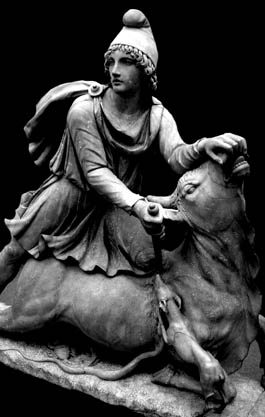
ANTINOUS MITHRAS
Another cult of ancient Rome that had its start in Phrygia is the Mysteries of Mithras and its more ancient cousin, the Orphic Mysteries. These were primarily a celestial, initiatory secret brotherhood, which looked toward the new discoveries in astronomy for its inspiration. A Bithynian by the name of Hipparchus noticed that a change in the occurrence of the Vernal Equinox seemed to take place when compared to the ancient Babylonian star charts. He believed that the sun was moving backwards through the Zodiac at a very slow rate. He set forth the theory that the stars were moving under the influence of a super cosmic force, but it took several hundred years for his belief to be verified. When it was, it became a new religion, that ttok much of its ideas from the Orphic myths that spoke of a deity who existed beyond the confines of our cosmos, having nothing to do with our world, a perfect being of purest light, of whom our world is a pail reflection. The religion of Mithraism was the result of this combination of Orphic, and astrological philosophy, mixed with a great deal of Platonic ideology. Mithras is represented as wearing the Phrygian cap, also called the cap of stars. It symbolized freedom, and was therefore placed on the head of a freed slave. Theologically the freedom that Mithras initiated was freedom from the confines of the world, and from mortal death. The ancient Greek religion had for thousands of years condemned the souls of the departed to the slumber of forgetfulness and oblivion in the underworld. The only means of escape from this eternal gloom was to accomplish the immortality by gaining fame by heroic deeds. Mithraism offered a new alternative to the soul of any who underwent the secret initiations of the celestial god, in which the soul was guided through the seven planetary spheres that imprisoned life on Earth. Mithraism spread rapidly through the Empire at the same time that the Gospel of Jesus was taking root. The two faiths are deeply related to one another, and were for some time in close competition. Christianity triumphed because it was open to all, whereas Mithraism was limited to men. It is believed by many that Antinous and Hadrian, being ever curious and profoundly religios, might have underwent the secret initiations, and were included in the salvation that Mithras had shown to the world. The secret of the Star of Antinous, its location and the implied message that it portrays have all the attributes of Mithraism, and there are one or two images that show Antinous wearing the Phrygian cap of Stars. One can therefore view Antinous in his role as the god of the Age of Aquarius, as the successor to Mithras who was the god of the Age of Pisces.
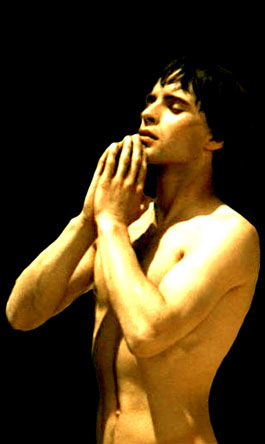
ANTINOUS THE GNOSTIC
Closely related to the Orphic and Mithraic mysteries is the Gnostic revolution that came to flower during the peaceful and liberal reign of Hadrian. The Gnostics took the ideas of Pythagoras and Plato, the Orphic Myths, Greco-Babylonian Astrology, the Egyptian doctrine of Maat, and the Christian Gospel and turned them completely around. Essentially, the Gnostics said that the creator of this world was an impostor who claimed to be the one true god, but that there was another being higher and more powerful, that no one could ever know or understand, that was beyond even the comprehension of the God of this World. They claimed that the creator of our world and his angels, had taken the light that was just a reflection of this highest being, and had imprisoned it within flesh and matter, making what was immortal, subject to death and decay. One who understood this had the power to reject the domination of the creator of the world and could over come him, putting an end to the cycles of reincarnation that kept our souls enslaved to the cycles of life and death. One who had obtained the Gnosis could rise up and rejoin the origin of all light and all love, that was the Unknown God who resides beyond our small and dark universe. The greatest teachers of this revolutionary doctrine lived during the time of Hadrian and Antinous and taught in Alexandria Egypt. Among them St. Valentine, after whom our famous holiday of lovers is named, and another by the name of Carpocrates, who was present in Alexandria when the Imperial court passed through the city. The Holy City of Antinopolis offered safe haven for free thinker of all kinds, and was a welcome home to the various schools of Gnosticism. Their ideas seem to have colored the religion of Antinous, especially since they were open to homosexuality. The death of Antinous is traditionally seen as a sacrifice for the benefit Hadrian and of the Roman Empire, but it can also be seen through the Gnostic philosophy as the denial of Antinous to continue in the world of the death and rebirth. It has always been suspected that one of the impulses that caused Antinous to jump into the Nile was the desire to preserve his youthful beauty from age and decay. Some have suggested from the evidence later statues, that his boyish face was beginning to take on an adult visage, hair was beginning to cloud his perfect cheeks. If this is so, then Antinous was indeed throwing himself into the Gnostic ideal of surrendering the mortal flesh in its most perfect state, in favor of the eternal and unknowable mystery of what lay beyond the cosmos, and the great river of the stars.

ANTINOUS CERNUNOS
The Wild God of the Forest represents a primordial force in human consciousness, perhaps one of the most ancient recognizable images which still resonates deeply and powerfully within our soul. The Horned God is half man, half animal, he represents something we both fear and aspire to become; wild, uncontrollable, unpredictable, dangerous and free. A creature of the night, of hidden dreams, the unexplainable, mystery of death, magic, the never-ending cascade of coincidence and paradox, all that is terrifying and powerful. The Horned God is both the Hunter and the Hunted, for this reason, among many, Antinous can very easily be understood through the Horned God, known as Cernunnos and by many other names among the Gallo-Romano-Celtiberian cultures of continental Europe. For those people who are of Gallo-Celtic ancestry, Antinous as Cernunnos can become a divine form through which to embrace their heritage. Antinous-Cernunnos can also be worshipped as a gay male aspect of the traditional Wiccan Horned God, because of his nature as a Bithynian Hunter who became a lord of the underworld, Antinous represents very closely what the Horned God is understood to mean and can therefore open doors for a gay male to embrace the Wiccan God, and likewise, for a Wiccan to understand and embrace Antinous.
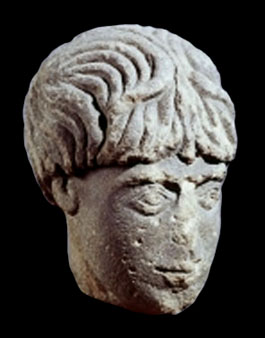
ANTINOUS ANTENOCITICUS
The religion of Antinous also made its way to the people of the North. First among the Celtic tribes, under the auspices of their deities Maponos, and Belenus. He was understood by the Celtic people as being one of a line of youthful, princely deities who having once been mortal had obtained immortality through heroic accomplishments. The most innovative aspects of the Celtic Antinous is being put forth by Phillip Bernhardt-house, Doctor of the Church of Antinous. A Temple of a little known deity named Antenociticus was uncovered a century or so ago in a fortress settlement built as part of Hadrian's great wall that stretches from one end of England to the other. The wall was built mostly before Antinous came into Hadrian's life, but this Temple seems to have been constructed after the religion of Antinous spread throughout the world. The names of the two deities have a very familiar ring, and may be due to mispronunciation, or to a more deliberate effort to assimilate Antinous into the Romano-Britannic religion of the surrounding populous. This Antinous-Antenociticus is important because he shows that the spirit of Antinous found its place even amongst the ancestors of the English speaking nations, who have now emerged as the inheritors of his new religion. Although Britania was the farthest extreme of Rome, it has become her fulfillment in the modern world. The British Empire and her daughter, American popular culture are the New Rome. The ideal of world peace and stability that was Hadrian's dream is finding its first realization since his golden age. This seed of Antinous, planted in a small, obscure Temple on the very frontier of the great, loving Roman Empire of age of the Antonines, has blossomed in our time. Veneration of this Celtic deity is veneration of the same boy who fell into the Nile.











